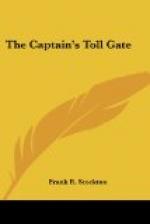There is one other notable characteristic that should be referred to in writing of Mr. Stockton’s stories—the machines and appliances he invented as parts of them. They are very numerous and ingenious. No matter how extraordinary might be the work in hand, the machine to accomplish the end was made on strictly scientific principles, to accomplish that exact piece of work. It would seem that if he had not been an inventor of plots he might have been an inventor of instruments. This idea is sustained by the fact that he had been a wood-engraver only a short time when he invented and patented a double graver which cuts two parallel lines at the same time. It is somewhat strange that more than one of these extraordinary machines has since been exploited by scientists and explorers, without the least suspicion on their part that the enterprising romancer had thought of them first. Notable among these may be named the idea of going to the north pole under the ice, the one that the center of the earth is an immense crystal (Great Stone of Sardis), and the attempt to manufacture a gun similar to the Peace Compeller in The Great War Syndicate.
In all of Mr. Stockton’s novels there were characters taken from real persons who perhaps would not recognize themselves in the peculiar circumstances in which he placed them. In the crowd of purely imaginative beings one could easily recognize certain types modified and altered. In The Casting away of Mrs. Leeks and Mrs. Aleshine he introduced two delightful old ladies whom he knew, and who were never surprised at anything that might happen. Whatever emergency arose, they took it as a matter of course, and prepared to meet it. Mr. Stockton amused himself at their expense by writing this story. He was not at first interested in the Dusantes, and had no intention of ever saying anything further about them. When there was a demand for knowledge of the Dusantes Mr. Stockton did not heed it. He was opposed to writing sequels. But when an author of distinction, whose work and friendship he highly valued, wrote to him that if he did not write something about the Dusantes, and what they said when they found the board money in the ginger jar, he would do it himself, Mr. Stockton set himself to writing The Dusantes.
I have been asked to give some account of the places in which Mr. Stockton’s stories and novels were written, and their environments. Some of the Southern stories were written in Virginia, and, now and then, a short story elsewhere, as suggested by the locality, but the most of his work was done under his own roof-tree. He loved his home; it had to be a country home, and always had to have a garden. In the care of a garden and in driving, he found his two greatest sources of recreation.
[Illustration: Claymont, Mr. Stockton’s home near Charles town, west Virginia.]




